
The foxface rabbitfish, also known as the foxface, black-face rabbitfish or the common foxface is a species of marine ray-finned fish, a rabbitfish belonging to the family Siganidae. It is found in the Indian and Pacific Oceans. It can be found in the aquarium trade.

Cirrhilabrus, the fairy wrasses, is a genus of fish in the family Labridae native to coral reefs and nearby habitats in the Indo-Pacific region. They are brightly colored and do not surpass 16 cm (6.3 in) in length. Males are larger and more colorful than females. They are commonly kept in aquaria.

Apolemichthys griffisi, or Griffis angelfish, is a species of ray-finned fish, a marine angelfish belonging to the family Pomacanthidae. It is found in the Pacific Ocean. It is a rarity for the species to enter the aquarium trade.
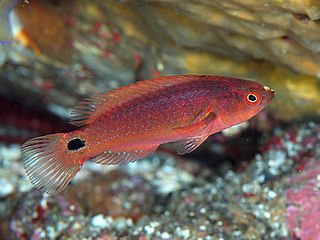
The exquisite wrasse is a species of ray-finned fish from the family Labridae, the wrasses, which is native to reefs in the Indo-West Pacific region. It can be found in the aquarium trade.
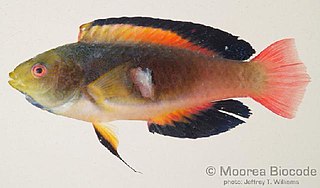
Scotts' wrasse is a species of wrasse native to the Pacific Ocean, where it occurs at depths of 3 to 40 m on coral reefs from Australia's Great Barrier Reef to the Pitcairn Islands. It can reach a total length of 13 cm (5.1 in). It is found in the aquarium trade.

Jansen's wrasse is a species of ray-finned fish, a wrasse from the family Labridae which is native to the Indian Ocean and Pacific Ocean. In the south-western Pacific Ocean it is replaced by sibling species black-barred wrasse. It can be found in the aquarium trade.

The slingjaw wrasse is a species of wrasse from the family Labridae which is native to the tropical waters of the Indo-Pacific where it occurs around coral reefs. This species is of minor importance to local commercial fisheries and can be found in the aquarium trade. Relatively mundane at first glance, this fish is notable for its highly protrusible jaws.

The blackspot tuskfish is a wrasse native to the Indian Ocean and the western Pacific Ocean from Mauritius to Indonesia and Australia north to the Ryukyus. This species occurs on reefs, preferring areas with sandy substrates or areas of weed growth. It can be found at depths from 10 to 60 m, though rarely deeper than 20 m (66 ft). It can reach 100 cm (39 in) in TL, and the greatest published weight for this species is 15.5 kg (34 lb). It is important to local commercial fisheries and is also farmed. It is popular as a game fish, in particular with spearfishers, and can be found in the aquarium trade.

Chaetodon pelewensis, the dot dash butterflyfish, spotbanded butterflyfish or punctato butterflyfish, is a species of marine ray-finned fish, a butterflyfish belonging to the family Chaetodontidae. It is found in the western Pacific Ocean.

Chaetodontoplus melanosoma, the black-velvet angelfish, brown angelfish, or phantom angelfish, is a species of marine ray-finned fish, a marine angelfish belonging to the family Pomacanthidae. It is found in the western Pacific Ocean.
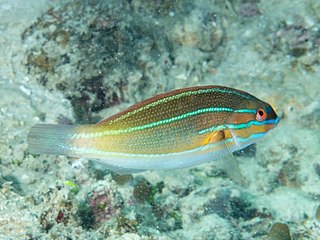
Stethojulis trilineata, also known as the blue-ribbon wrasse, red shouldered rainbow-fish, scarlet-banded rainbowfish, three-blueline wrasse, three-lined rainbowfish or three-lined wrasse, is a species of marine ray-finned fish, a wrasse from the family Labridae. It is found in the Indo-Pacific region where it is associated with reefs.

The blackear wrasse is a species of wrasse, a type of fish in the family Labridae, from the warmer waters of the western Atlantic Ocean.
Cirrhilabrus shutmani, also known as the magma fairy wrasse, was discovered by RVS Fishworld in 2016 living around the Didicas Volcano in the Babuyan Islands of the Philippines. The magma wrasse belongs to the family of 'Labridae', a colourful species of tropical and subtropical fish. The magma wrasse is found in tropical coral reef, within the depth range of 50–70 metres (160–230 ft). This species of fish usually inhabits steep slopes around coral reefs made up of loose rubble. It can be purchased within the aquarium trade.
Cirrhilabrus blatteus or the purple-boned wrasse is a species of fairy wrasse native to the coasts of Egypt, Eritrea, Israel, Jordan, Saudi Arabia, Sudan, and Yemen in the Gulf of Aqaba. The species can be found at depths of 40 to 50 meters.

Cirrhilabrus pylei, commonly called the blue-margin fairy-wrasse or Pyle's wrasse, is a species of fairy wrasse. It can be found in depths of 55 to 82 m (180–269 ft) in Indonesia, Papua New Guinea, Solomon Islands and Vanuatu; reports from the Philippines is due to confusion with C. briangreenei. C. pylei can be kept in aquariums and is known for its peaceful temperament. The fish has also been known to jump from tanks.

Latent sling-jaw wrasse is a species of ray-finned fish from the wrasse Family Labridae which is associated with reefs in the south-western Pacific Ocean.
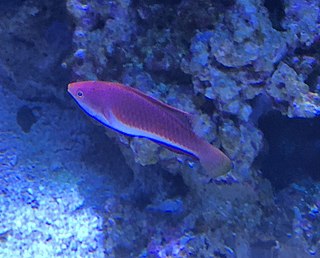
Cirrhilabrus cyanogularis, also known by its common name blue-throated fairy wrasse, is a species of the fairy wrasse family, which may also be known as sailfin fairy wrasse. It originates from Indonesia to the Philippines. The name cyanogularis comes from the Greek for 'blue throat', this refers to the brilliant cerulean breast that is seen in males. It’s perhaps most prominent in Cirrhilabrus cyanogularis have the closest relatives showing this same feature to some extent. This also holds for its extended family in Melanesia and in the Indian Ocean. The male Cirrhilabruscyanogularis has a large blue patch on the throat below the eyes and its head and body are orange to orange-red, and the lower part of the head white and with a series of fine white stripes. The female is similar to the male, its body is uniformly orange to orange-red with three to four fine white stripes dorsally.

Cirrhilabrus earlei is a species of fairy wrasse. They occur in the Western Central Pacific, Palau and Micronesia. In 2001 John Randall and Richard Pyle officially documented and described the species. Cirrhilabrus earlei is the known to the twilight reefs of Palau and the Majuro Atoll in the Marshall Islands. They live under depth range of 60–92 m, and its length is 6.9 cm SL. Male Cirrhilabrus earlei are adorned with sword-shaped tails, the tiny female species are same as male stimulates the male into the nuptial.

Cirrhilabrus finifenmaa, also known by its common name rose-veiled fairy wrasse, is a rainbow-colored wrasse that is native to the reefs of the Maldives.
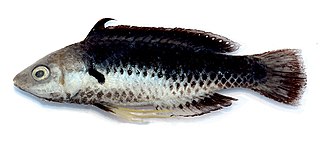
The monsoon fairy-wrasse is a species of fish in the wrasse family, originating from the eastern Timor Sea. It matures at a length between 5 and 6 cm. They can be found at a depth of around 20 metres (66 ft). It is described from 19 type specimens. The species complex consists of five other Indo-Pacific species: Cirrhilabrus joanallenae, Cirrhilabrus humanni, Cirrhilabrus morrisoni, Cirrhilabrus naokoae, and Cirrhilabrus rubriventralis. Cirrhilabrus morrisoni and new Cirrhilabrus humanni relatively new adjoining natural ranges with Cirrhilabrus hygroxerus. The Australian version of Cirrhilabrus hygroxerus has bright white ventral part in its body and the rest of the female monsoon wrasses.


















